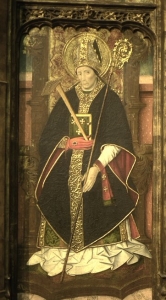| A
hierarchical ordering of Christian ministry in the ranks of bishop,
priest, and deacon. |
 |
|
Bishop
with symbols of office: chair, scepter, rod, bible, crown and mantle
|
Threefold ministry:
In this ordering bishops preside over a given locality assisted by a second
group of ministers, presbyters, or priests, and a third group, deacons.
The church of the New Testament era had a plethora of offices in varying
places. In some places there seems to have been greater definition of
these offices and in other places lesser definition. Nomenclature is fluid
throughout this era. None of these offices more than anticipates the later
offices defined by the threefold ministry. Nowhere in the New Testament,
for example, is there an indication that presidency at Holy Communion
is attached to any office.
Bishop:
In the New Testament, bishops and presbyters are usually synonymous,
and most often functioned as a group. In the beginning of the second
century Ignatius of Antioch contends
for the rule of one bishop over both presbyters and deacons in the congregation.
By the end of the second century the common pattern was for one bishop
to preside over a group of presbyters and deacons in a single congregation,
although patterns continued to vary for some time. Bishops in the West,
for example, retained early on the privilege of completing baptisms
by anointing baptizands with oil. This is the origin of the rite of
confirmation in the West. In the East this ritual remained a part of
the rite of baptism and was administered by presbyters. In both East
and West, bishops were increasingly accorded the power to ordain after
this rite gained identity. This pattern eventually entirely displaced
the previously diverse commissioning practices of the church of the
New Testament era.
Presbyter:
As the church grew larger presbyters assumed the care of individual
congregations while bishops oversaw groups of congregations and retained
certain prerogatives not only in the region but in individual congregations.
The office of presbyter was primarily defined by the privilege to administer
the sacramental rites in the congregation, although ordination was early
restricted to bishops in both East and West. Confirmation as well was
restricted to bishops in the West.
Deacon:
In the New Testament, deacons have a variety of functions. Although
some may have been given the function of distributing food, many functioned
as evangelists, teachers, and readers. Later, deacons were thought of
primarily as assistants to bishops and presbyters. As the office gained
definition in the early centuries, deacons were assigned liturgical
duties including the reading of lessons from the epistles and the gospels,
the gathering of alms, dismissal of the catechumens,
and the distribution of the elements to communicants. Deacons were also
often responsible for the administering of alms in the congregation.
There were also women deaconesses in the
early church.
|